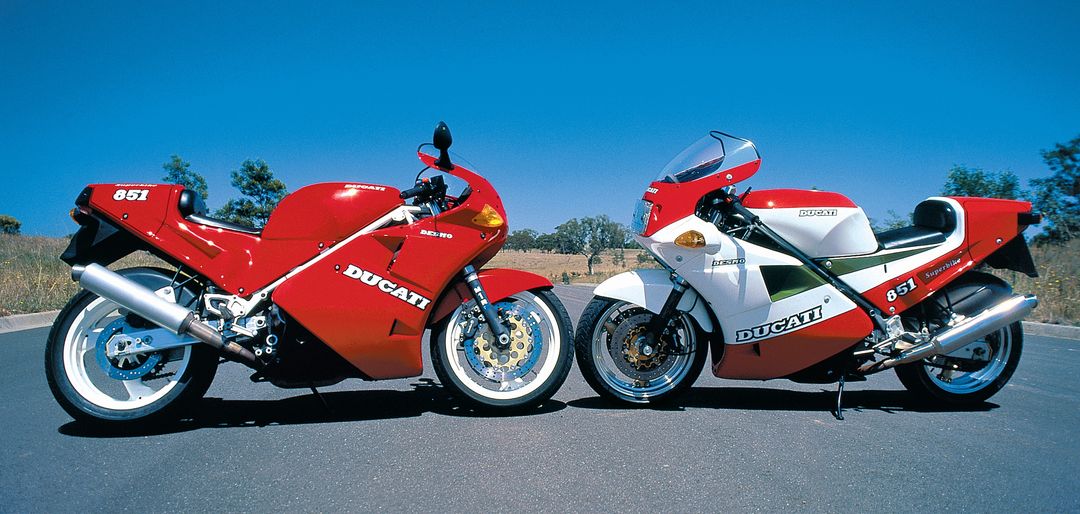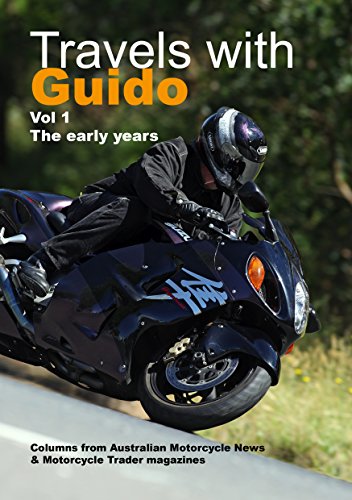Motorcycle Investor mag
Subscribe to our free email news
Ducati 851 profile
(by Ian Falloon, June 2022)

Falloon on the fascinating but flawed ground-breaker for Ducati
1988 was the first year for
the World Superbike Championship, and with the
requirement for 200 machines to be built for
homologation, Ducati produced the 851 Superbike Kit and
Strada.
Known as the “Tricolore”
because of the distinctive red, white, and green colour
scheme, 207 Superbike Kits and 304 Stradas were
constructed and sold at a premium price. Unfortunately,
while they promised much, they were under-developed. The
strange equipment typified the idiosyncratic Ducati
foibles of that era.
As a homologation special the
851 Superbike Kit was possibly the more flawed of the
two 1988 production versions. Although much of the
specification was of a high standard, with a claimed
120bhp the engine performance was lacking for racing.
While the Superbike Kit came
shod with racing slicks on 17-inch magnesium Marvic
wheels and was definitely not street legal, somewhat
surprisingly it also had a headlight, taillight, and
electric start. Thus it was decidedly overweight despite
an optimistic claim of 165kg. The dry weight was more in
the region of 189kg, this rising to around 200kg fully
wet.
Although obviously too heavy
for a real racing machine, the Superbike Kit did at
least offer acceptable handling. This couldn’t be said
of the more street oriented 851 Strada that came with
Marvic/Akront 16-inch wheels and provided unusual
steering. These wheels seem to have been left over from
the limited edition 750 Montjuich and Santamonica
production run and were unsuited to the larger 851.
The 851 Superbike Kit and
Strada may have been limited edition models with many
individually fabricated pieces but they were a
disappointment. The Superbike Kit was neither racer nor
roadster and while the Strada provided exceptional
performance for a twin the premium price ensured many
remained unsold through until 1989.
Still, the 851 Strada
undoubtedly raised the stakes for street motorcycle
two-cylinder performance. The Italian magazine Moto
Sprint has often received the first test machines
out of the factory and they achieved a top speed of
238.7km/h with a standing start 400 metres in 11.03
seconds at 197.207km/h.
While the 1988 851 Strada was
flawed, fortunately Ducati made amends with the improved
851 Strada of 1989. Although no longer a limited
production model (751 were constructed), functionally
the 1989 851 was a vastly improved machine over the
Tricolore Strada.
Central to the improvement
for 1989 were 17-inch wheels front and rear, the rim
sizes of 3.50 and 5.50 inches being identical to those
on the 851 Superbike Kit those the wheels were aluminium
Brembo. These sizes were state-of-the-art for the time
and remain so, identical sizes continuing on the current
996.
Also contributing to the
superior steering was a reduction in the steering head
angle, to 24.5 degrees and less trail at 94mm.
Although the Weber IAW 043
(07) injection system now featured only a single
injector per cylinder, the engine still had the Pankl
H-section con-rods. With an 11.0:1 compression ratio
there was a slight power increase to 105bhp at 9000rpm
(at the crankshaft).
Other improvements over the
earlier Tricolore included twin 320mm front discs,
though these were no longer the fully floating cast-iron
type. Setting off the revised 851 Strada was distinctive
red paintwork. The 1989 Strada performed similarly to
the earlier model, with Moto Sprint managing a top speed
of 240.9km/h and a standing start 400 metre time of
11.11 seconds at 194.877km/h.
-------------------------------------------------
Produced by AllMoto abn 61 400 694 722
Privacy: we do not collect cookies or any other data.

Archives
Contact





